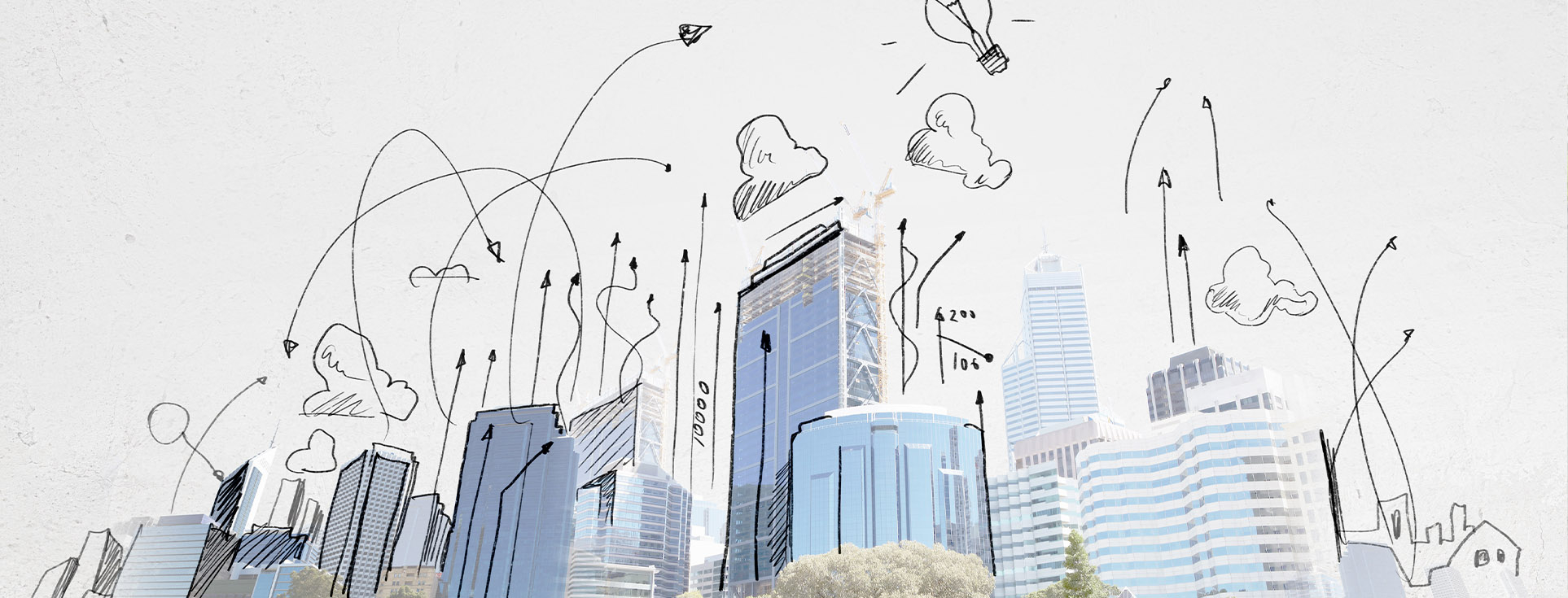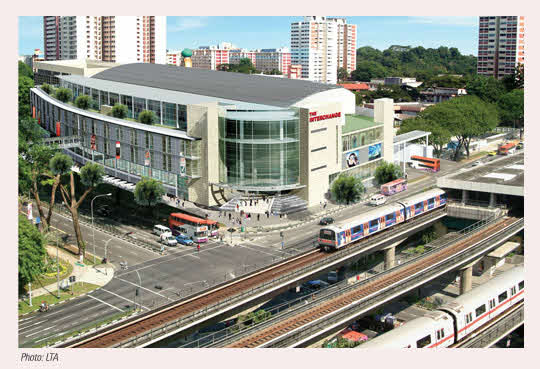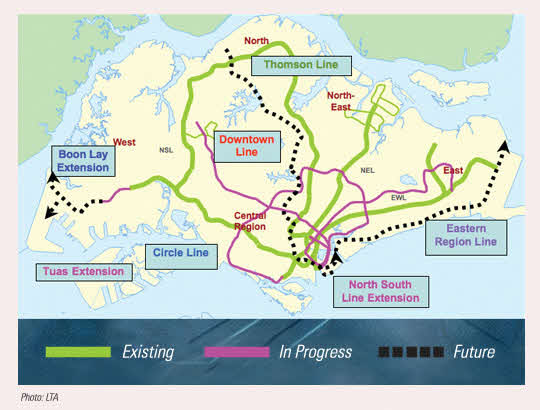Designing Urban Journeys
World Cities Summit Issue, June 2008

In “Transportation for Livable Cities”,1 Vukan R. Vuchic described a liveable city as one that is human-oriented and environmentally friendly; economically viable and efficient; and socially sound. An efficient land transport system plays a critical role in developing a liveable city. Over the next few years, Singapore will see developments such as the Youth Olympic Games, Formula One Grand Prix, the Integrated Resorts and the Singapore Sports Hub. The city’s transport policies have to consider the new demands and anticipate future needs in order to support the sustainable development of the city.
So far, Singapore’s land transport policies have established an efficient and extensive transport network. Increasingly, the Land Transport Authority (LTA) recognises the social role of transport: it has to be accessible and meet the diverse needs of our people, including the lower-income groups and the physically-challenged.
Like other cities around the world, developing transport policies in Singapore has its challenges. Daily travel demand in Singapore is projected to increase by 60%, from the current 8.9 million journeys a day to 14.3 million by 2020. This is due to an increase in population and tourist arrivals, as well as increased economic activities generated by a buoyant economy. As Singapore is a small and densely built-up city-state with limited land, it is not sustainable to build more roads indefinitely to cater to the increased travel demand. At the moment, roads take up 12% of our land, compared with 15% for housing. Hence, our transport policies have to make the best use of limited resources to meet the additional demand, using existing infrastructure.
Like most developed cities, the Singapore population is ageing. At the same time, rising affluence means that expectations of people have changed. While public transport has to be fast and efficient to cater to the masses, it also has to remain accessible and affordable to the less privileged. In addition, given the negative impact of transport on the environment, our transport policies should also give due emphasis to protecting the environment. For a city to be liveable, vibrant and attractive to its residents, a well-planned and accessible land transport system is fundamental to the city’s sustained growth in the future.
Public transport in Singapore has to be fast and effi cient to cater to the masses, and also remain accessible and affordable to the less privileged.
As the result of a year-long comprehensive review of the 1996 White Paper on Land Transport and in light of the new challenges ahead, LTA released the Land Transport Master Plan: A People-Centred Land Transport System2 in January this year. The Master Plan outlines three strategic thrusts which will shape the land transport development and policies over the next 10 to 15 years. These are: Making Public Transport a Choice Mode; Managing Road Usage; and Meeting the Diverse Needs of the People. The objective of the Master Plan is to build a more people-centred land transport system that supports a vibrant and liveable city.
MAKING PUBLIC TRANSPORT A CHOICE MODE
To make public transport a choice mode of travel requires a change in will and mindset. Based on load analysis, public transport is the most efficient people-mover and also an environmentally sustainable mode of travel. A Mass Rapid Transit (MRT) train carries an average of 1,100 passengers at any one time during the peak period, while a single deck bus can carry about 80 passengers—contrast this with the average occupancy of about 1.5 persons per car. This means that it will take more than 50 cars to move one bus-load of passengers, and more than 700 cars to move one train-load of passengers. For a city like Singapore, it would put a tremendous strain on the road network if everyone were to choose to travel by car.
A survey by LTA showed that between 1997 and 2004, the number of car trips increased by 23%, more than double the 10% increase in car population over the same period. This increased propensity to drive means that the public transport mode share has been declining over the years, from 67% in 1997 to 63% in 2004. We believe that the increase in travel demand must be met by public transport. Hence, in the Land Transport Master Plan, we aim to reverse this decline. The target is to achieve a public transport mode share of 70% for the morning peak hours by 2020, up from 63% today.
Our transport system must constantly evolve to cater to the changing demographics and the higher expectations of the population. However, public transportation cannot be solely designed from the policy vantage point. It must be planned and built from the commuter’s point of view. This means understanding and catering to commuter needs from the moment they leave their homes to the time they reach their destinations. This is the only way to ensure that transport is human-oriented. For instance, to enhance the overall journey experience, more covered linkways and overhead bridges will be provided so that commuters can enjoy a pleasant walk to the bus stops, bus interchanges or MRT stations. To complement this, more integrated transport hubs like the ones at Ang Mo Kio or Toa Payoh bus interchanges will be created (Figure 1). By co-locating bus interchanges with MRT stations and commercial development, transfers between bus and train will be more convenient. Commuters can shop or pick up a drink while waiting for their buses or trains, all in air-conditioned comfort. The aim is to transform these transport nodes into fun and exciting places, create more buzz and provide greater comfort and convenience for the commuters. Similarly, providing more real-time public transport travel information would allow commuters to better plan their journeys even before they leave their homes. It is the entire experience of the journey that will help make public transport an attractive mode of travel.
FIGURE 1. IMPRESSION OF ANG MO KIO HUB

In Singapore, we adopted the hub-and-spoke model for our public transport network. This essentially means relying on buses or Light Rapid Transit (LRT) to serve as feeder services, bringing commuters to MRT stations or bus interchanges. The rail network will remain as the backbone of our public transport system given its higher speed and capacity. To increase its coverage and availability, the rail network will be doubled by 2020 where existing lines will be extended, and new lines added (Figure 2). This will benefit commuters in areas currently not served by the MRT.
FIGURE 2. EXISTING AND FUTURE RAIL LINES BY 2020

While the hub-and-spoke model is more efficient in land-scarce Singapore compared with direct services for every origin and destination, transfers are inevitable in such a system. Today bus routes are planned by the two public transport operators: the SMRT Corporation Ltd (SMRT) and the SBS Transit Ltd. Being profit-driven companies, their decisions are largely based on commercial considerations. There is little integration between the systems run by the SMRT and SBS Transit as there is no incentive for them to do so. This has led to a situation where buses are less frequent than they should be, and feeder buses run long and circuitous routes before getting to the MRT station or bus interchange. This results in longer waiting and transfer times for commuters. Thus, to enhance the hub-and-spoke model, the LTA has decided to take over the planning of bus routes so that a more commuter-centric approach is taken when bus routes are planned, with due consideration given to other transport infrastructure such as the rail and road network. With better integration between bus and rail, commuters will be able to experience an overall improvement in journey time.
While public transport has to cater to the masses, we recognise that commuters have different needs. For example, some prefer taxis which provide personalised door-to-door service. More can be done to attract those who have higher expectations of the public transport system. LTA will be working closely with the public transport operators to offer more public transport choices to this group of commuters. It will also be promoting and facilitating niche services such as the premium bus services, which provide greater comfort and more direct journeys to those who are willing to pay a higher price.
MANAGING ROAD USAGE
Roads are the arteries of our economy. Everyday, nearly 9 million journeys are made, with about 40% in private vehicles—and this number is growing. Our roads have to remain smooth-flowing to support economic activities so that goods and people can reach their destinations on time. If demand for road usage is not managed well, traffic congestion will become commonplace, as seen in other major cities in Asia. Road congestion results in economic loss as well as externalities such as noise and air pollution. Quality of life will be affected if daily commute turns into long, arduous journeys with constant gridlock amidst noise and air pollution.
Congestion needs to be managed in a holistic manner. While improving public transport is key to managing demand on our roads, this alone is not sufficient. Where feasible, the road network will be expanded to serve new developments but we are mindful that additional lanes and new roads inevitably attract more traffic which eventually leads to congestion. At the same time, technology will be leveraged to maximise existing road capacity. The LTA is expanding the coverage of electronic Junction Eyes3 and the Expressway Monitoring and Advisory System (EMAS)4 to more junctions and arterial roads. These surveillance systems allow LTA to monitor traffic conditions on the roads and deploy measures to rectify causes of traffic congestion expeditiously. Some people have argued that these measures are enough to manage congestion and that road pricing is unnecessary. However, after studying the experience of other cities, it has shown that even with a first-class public transport system, people will continue to drive unless there are measures (for example, implement high parking charges in the city) which discourage them from doing so.
In Singapore, we rely on policy tools such as the Vehicle Quota System to control the growth in vehicle population, and the Electronic Road Pricing (ERP)5 system to manage demand on congested roads. We have found that ERP is by far the most effective and direct means of managing congestion because it requires motorists to take into account the cost of congestion to others as a result of their driving. The aim of the system is to influence the motorist’s decision, so that he may consider driving during off-peak hours or even motivate him to use alternative modes of transport.
The ERP scheme has remained largely the same since it was introduced 10 years ago. As part of the development of the Land Transport Master Plan, the LTA also conducted a review on the ERP system to enhance its effectiveness so that it is more responsive to changing traffic conditions. As a result of the review, it was decided that the method of measuring traffic speeds on ERP-priced road would be refined to assure that at least 85% of motorists travelling on these roads will be assured of smooth travel; the ERP rate structure needs to be updated in order for it to make a significant difference in influencing motorists’ behaviour; and the congestion in the city area have to be managed through the introduction of additional ERP gantries.
Yet, even through the enhancement of ERP, the current vehicle growth rate of 3% is not sustainable and we will lower it to 1.5% from May 2009.
MEETING THE DIVERSE NEEDS OF THE PEOPLE
While public transport has to cater to the masses, the system must also remain accessible to others with special needs, such as the elderly, wheelchair-bound commuters, and parents with infants or young children. Wheelchair-accessible buses and barrier-free facilities in MRT stations are already available, but more will be done to improve accessibility. By 2010, pedestrian walkways, access to MRT stations, taxi and bus shelters, and public roads across the island will be barrier-free; by 2020, the public bus fleet will be fully wheelchair-accessible. Additional lifts will also be installed at MRT stations so that commuters need not make long detours to look for an entrance with lift.
As we enhance the quality of our public transport services, we are mindful that public transport should remain affordable to the masses. The Government’s policy is to regulate fares to ensure public transport remains affordable to the majority. Instead of keeping fares at artificially low levels, they are allowed to go up in small regular steps to keep pace with inflation. For the lower-income groups who need financial assistance, help is available through various government assistance schemes or community schemes such as public transport vouchers, which is a joint effort by the National Trades Union Congress (NTUC),6 public transport operators and the Government.
Initiatives to promote public transport and manage congestion on the roads are key steps towards sustainability. LTA works closely with the Ministry of the Environment and Water Resources as well as the National Environment Agency (NEA) to encourage motorists to choose cleaner and more energy-efficient vehicles, such as hybrid cars, and adopt environmental-friendly practices.
LTA also adopts environmentally sustainable practices in planning and developing land transport infrastructure. One such initiative is the use of recycled municipal, road and building waste materials currently being disposed of at the Pulau Semakau Landfill7 in road resurfacing works and road pavement construction. This measure, which is being jointly undertaken with NEA, SPRING Singapore8 and industry players, will potentially extend the lifespan of the Pulau Semakau Landfill by another 25 years. This is a significant contribution to protect our environment, especially in land-scarce Singapore. Going forward, we will have to think of new ways to support environmental goals.
A PEOPLE-CENTRED SYSTEM
Transport affects people in different ways. To have a people-centred land transport system, LTA engages the public to understand their needs and expectations. As part of the year-long Land Transport Review that was conducted while developing the Master Plan, an extensive public consultation exercise was conducted through various channels over several months. Focus group discussions were held where members of the public and other stakeholders were invited to discuss and share their views. LTA also went online to seek feedback via the Talk2LTA portal and created an online game called the “Great Transport Challenge 2020”. More than 4,500 people gave their views and feedback.
Engaging the people has to be a continual effort. LTA actively engages residents and communities who are affected by our infrastructure works. These stakeholders are frequently updated on the progress of the projects and how they might be affected. At the same time, LTA would seek their understanding for inconveniences caused by existing works as well as ask for feedback. LTA recently set up a Land Transport Community Partnership Division where dedicated teams from this Division are assigned to each constituency to handle the day-to-day road and traffic management issues more effectively, and to establish a closer relationship with the community. To foster stronger rapport, the Community Outreach Programme will periodically share and discuss LTA land transport policies and plans with grassroots leaders.
In January this year, LTA opened the Land Transport Gallery which showcases the development of the Singapore land transport system since 1945. This Gallery helps to promote better awareness of the intricacies and challenges of land transport policies and encourage an open exchange of ideas to improve the system. Through the various engagement efforts, we hope that there will be greater ownership of the land transport system.
By 2020, Singaporeans will have a more advanced public transport system. Our continual goal is to manage road usage and protect the environment. Land transport plays a critical role as Singapore strives to be a city that is human-oriented and environmentally friendly, economically viable and efficient, and socially sound—a truly liveable city.
Yam Ah Mee is Chief Executive of the Land Transport Authority (LTA). He led the Authority in the Land Transport Review which unveiled major initiatives to enhance the land transport system in Singapore over the next 10 to 15 years. Under his leadership, LTA has embarked on many initiatives to improve public transport, such as the expansion of the rail network, the introduction of wheelchair-accessible buses, barrier-free accessibility around train stations and bus interchanges, and the implementation of real-time bus arrival information. Mr Yam was previously Deputy Secretary (Sea & Air) in the Ministry of Transport.
NOTES
- Vuchic, Vucan R., Transportation in Livable Cities (New Brunswick, New Jersey: Center for Urban Policy Research, 1999).
- The full report may be viewed online at https://www.lta.gov.sg/content/ltagov/en.html
- Junction Eyes is a system of surveillance cameras at signalised junctions to spot and rectify causes of traffic congestion.
- EMAS performs live-video traffic surveillance, incident and violation detection, and traffic advisory functions.
- ERP is an electronic system of road pricing based on pay-as-you-use principle. Motorists are charged when they use the road during peak hours.
- The NTUC is a national federation of trade unions of workers in the industrial, service and public sectors.
- The Pulau Semakau Landfill is Singapore’s offshore landfill for waste disposal.
- SPRING Singapore is the agency for enterprise development. It aims to grow competitive and innovative enterprises.

